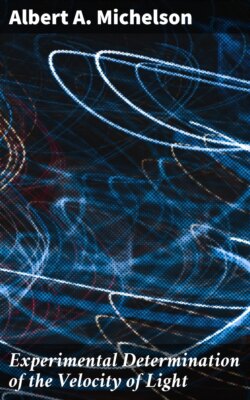Читать книгу Experimental Determination of the Velocity of Light - Albert A. Michelson - Страница 4
На сайте Литреса книга снята с продажи.
Introduction.
ОглавлениеTable of Contents
In Cornu's elaborate memoir upon the determination of the velocity of light, several objections are made to the plan followed by Foucault, which will be considered in the latter part of this work. It may, however, be stated that the most important among these was that the deflection was too small to be measured with the required degree of accuracy. In order to employ this method, therefore, it was absolutely necessary that the deflection should be increased.
In November, 1877, a modification of Foucault's arrangement suggested itself, by which this result could be accomplished. Between this time and March of the following year a number of preliminary experiments were performed in order to familiarize myself with the optical arrangements. The first experiment tried with the revolving mirror produced a deflection considerably greater than that obtained by Foucault. Thus far the only apparatus used was such as could be adapted from the apparatus in the laboratory of the Naval Academy.
At the expense of $10 a revolving mirror was made, which could execute 128 turns per second. The apparatus was installed in May, 1878, at the laboratory. The distance used was 500 feet, and the deflection was about twenty times that obtained by Foucault.[1]
[Footnote 1: See Proc. Am. Assoc. Adv. Science, Saint Louis meeting.]
These experiments, made with very crude apparatus and under great difficulties, gave the following table of results for the velocity of light in miles per second:
| 186730 |
| 188820 |
| 186330 |
| 185330 |
| 187900 |
| 184500 |
| 186770 |
| 185000 |
| 185800 |
| 187940 |
| ------ |
| Mean 186500 ± 300 miles per second, or 300140 kilometers per second. |
In the following July the sum of $2,000 was placed at my disposal by a private gentleman for carrying out these experiments on a large scale. Before ordering any of the instruments, however, it was necessary to find whether or not it was practicable to use a large distance. With a distance (between the revolving and the fixed mirror) of 500 feet, in the preliminary experiments, the field of light in the eye-piece was somewhat limited, and there was considerable indistinctness in the image, due to atmospheric disturbances.
Accordingly, the same lens (39 feet focus) was employed, being placed, together with the other pieces of apparatus, along the north sea-wall of the Academy grounds, the distance being about 2,000 feet. The image of the slit, at noon, was so confused as not to be recognizable, but toward sunset it became clear and steady, and measurements were made of its position, which agreed within one one-hundredth of a millimeter. It was thus demonstrated that with this distance and a deflection of 100 millimeters this measurement could be made within the ten-thousandth part.
In order to obtain this deflection, it was sufficient to make the mirror revolve 250 times per second and to use a "radius" of about 30 feet. In order to use this large radius (distance from slit to revolving mirror), it was necessary that the mirror should be large and optically true; also, that the lens should be large and of great focal length. Accordingly the mirror was made 1¼ inches in diameter, and a new lens, 8 inches in diameter, with a focal length of 150 feet was procured.
In January, 1879, an observation was taken, using the old lens, the mirror making 128 turns per second. The deflection was about 43 millimeters. The micrometer eye-piece used was substantially the same as Foucault's, except that part of the inclined plate of glass was silvered, thus securing a much greater quantity of light. The deflection having reached 43 millimeters, the inclined plate of glass could be dispensed with, the light going past the observer's head through the slit, and returning 43 millimeters to the left of the slit, where it could be easily observed.
Thus the micrometer eye-piece is much simplified, and many possible sources of error are removed.
The field was quite limited, the diameter being, in fact, but little greater than the width of the slit. This would have proved a most serious objection to the new arrangement. With the new lens, however, this difficulty disappeared, the field being about twenty times the width of the slit. It was expected that, with the new lens, the image would be less distinct; but the difference, if any, was small, and was fully compensated by the greater size of the field.
The first observation with the new lens was made January 30, 1879. The deflection was 70 millimeters. The image was sufficiently bright to be observed without the slightest effort. The first observation with the new micrometer eye-piece was made April 2, the deflection being 115 millimeters.
The first of the final series of observations was made on June 5. All the observations previous to this, thirty sets in all, were rejected. After this time, no set of observations nor any single observation was omitted.
